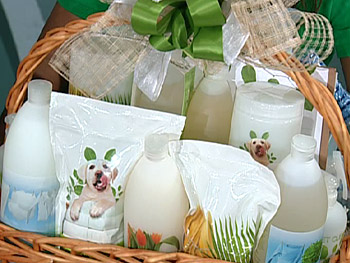We all need to clean our homes at some point! It may be time to clean your cleaners! Any cleaning substance you use ends up in the air, the water, or the soil and ultimately, inside your body and your children’s bodies. It seems there are different cleaners for every room and for every need. You’d think there were thousands of variations of dirt in your house. It might be time to minimize your use of toxic products in your home. Did you know:
- Many household products contain pesticides and toxic ingredients that can be harmful to humans, animals, or the environment. Even so, we use these products to clean or maintain our home. Or they are useful because they control disease-causing organisms, insects, weeds, or other pests.
- The average home generates over 25 pounds of toxic, hazardous waste each year. Much of this waste can be attributed to household cleaning products.
- 90% of poisonings occur in the home.
- An average of 200 banned toxic chemicals were found in 100 percent of pregnant women in a recent study.
Dr. Joyce Woods, in her book Create a Safe & Healthy Home, shares some statistics about our greatest exposure to chemicals being right in our own home:
- more than 72,000 synthetic chemicals have been produced since WWII.
- less than 2% of synthetic chemicals in widespread use have ever been tested for toxicity, birth defects or their mutagenic or carcinogenic effects.
- the average home today contains 62 toxic chemicals, more than a chemistry lab at the turn of the century.
Today, children have chemical exposures from birth that their parents didn’t have until they were adults.
- “Developing cells in children’s bodies are more susceptible to damage than adult cells that have completed development, especially for the Central Nervous System.”*
- “Until a child is approximately 13 months of age, they have virtually no ability to fight the biological and neurological effects of toxic chemicals.”*
* According to Herbert Needleman, MD in his book Raising Children Toxic Free (Needleman, M.D. and Landrigan, M.D.)
The Consumer Product Safety Commission reports that 150 chemicals that are commonly found in the home have been linked to allergies, birth defects and psychological abnormalities.
Chemicals are linked to so many health problems and are right under your nose: under your sink, in your shower, and all throughout the house. To make matters worse most people today spend 90% of their time indoors.
They wouldn’t sell it if it wasn’t safe…would they? ![]()
You Can’t Always Trust Labels Chemical based cleaning products may make our homes look clean on the surface, but look (and smell) closer and you will find that these items are hiding insidious effects. Many products on the market today (even the ones that sound “clean”) contain very-hard-to pronounce toxic chemicals, which are often not even indicated on the labels or hidden in generic terms such as fragrance. These toxic products may be innocently lying around the house, often within easy reach of unsuspecting children. Is your family’s health really worth the risk of using these noxious products? Watch out for these suspected carcinogens, endocrine disruptors or reproductive toxins commonly found in cleaning agents: ethylene glycol butyl ether, ethoxylated nonylphenol, methylene chloride, naphthalene, paradichlorobenzene, silica, toluene, trisodium nitrilotriacetate and xylene. They’re not only hard to pronounce and spell, they’re hard on the household budget, too, as a lot of these cleaners are quite pricey.
![]() What can you do to reduce your risks?
What can you do to reduce your risks?
By eliminating or reducing the use of toxic chemicals in your home you can make a significant difference in your life and the life of your family. How do you do this?
- Educate yourself of what is in the products you are using to clean your house, your car and your children.
- Read the labels and contact the company for a complete list of ingredients (Not all ingredients have to be listed on the label!).
- Buy organic products or “natural” products and limit your usage of products that may contain toxins.
- Limit your exposure to plastic products.
- Encourage others to take these precautions also.
Compare our Cleaners to Theirs….. The Shaklee Get Clean cleaning products are biodegradable, which means they break down easily instead of hanging out in the ground for hundreds of years. They also have no phosphates, borates, nitrates, or chemicals that are harmful to your family, pets or the environment. They are super concentrated so you add the water and we all can subtract waste: Less weight to ship, less to use, and less to throw away. Cleaners that are Good for the Environment When you purchase our Cleaning Starter Kit instead of ready-to-use products, you’re helping reduce over 100 pounds of packaging waste from landfills and eliminating 248 pounds of greenhouse gases – this is the environmental equivalent of planting 10 trees. Now you don’t have to sacrifice the earth or your health to get your house cleaned.
When you purchase our Cleaning Starter Kit instead of ready-to-use products, you’re helping reduce over 100 pounds of packaging waste from landfills and eliminating 248 pounds of greenhouse gases – this is the environmental equivalent of planting 10 trees. Now you don’t have to sacrifice the earth or your health to get your house cleaned.  And Cleaners that are Good for your Wallet The Cleaning Starter Kit replaces 830 bottles or boxes of conventional ready-to-use cleaning products you use in your house, kitchen and laundry – over $3400 of equivalent cleaning power.
And Cleaners that are Good for your Wallet The Cleaning Starter Kit replaces 830 bottles or boxes of conventional ready-to-use cleaning products you use in your house, kitchen and laundry – over $3400 of equivalent cleaning power.

Our Cleaning Starter Kit contains the equivalent cleaning power of:*
- 60 Bottles of Fantastik Multi-Purpose Cleaner, 32 oz.
- 32 Bottles of Mop & Glo Triple Action Floor Shine Cleaner, 32 oz.
- 728 Bottles of Windex Original Formula, 26 oz.
- 1 Bottle of Woolite Original Fabric Wash, 50 oz.
- 1 Container of Clorox Wipes, 35 wipes
- 1 Bottle of Soft Scrub Grease Cutting Lemon Cleanser, 26 oz.
- 2.5 Boxes of Cascade Regular Powder Auto Dish Detergent, 45 oz.
- 2 Boxes of Tide Original Liquid Detergent, 50 oz.
- 3 Bottles of Down Fabric Softener, 64 oz.
- 1 Box of Bounce Fresh Linen Scent Fabric Softener Sheets, 80 sheets
*Based upon a comparison of label usage directions. The comparison was conducted on July 10, 2006 and is valid only for the named products marketed at that time. All trademarks are the property of their respective owners.
Get started now … and go clean that house!
Image credit: kzenon / 123RF Stock Photo
